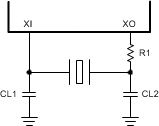ZHCSIS3D September 2018 – June 2025 DP83869HM
PRODUCTION DATA
- 1
- 1 特性
- 2 应用
- 3 说明
- 4 Device Comparison
- 5 Pin Configuration and Functions
- 6 Specifications
-
7 Detailed Description
- 7.1 Overview
- 7.2 Functional Block Diagram
- 7.3
Feature Description
- 7.3.1 WoL (Wake-on-LAN) Packet Detection
- 7.3.2 Start of Frame Detect for IEEE 1588 Time Stamp
- 7.3.3 Clock Output
- 7.3.4 Loopback Mode
- 7.3.5 BIST Configuration
- 7.3.6 Interrupt
- 7.3.7 Power-Saving Modes
- 7.3.8 Mirror Mode
- 7.3.9 Speed Optimization
- 7.3.10 Cable Diagnostics
- 7.3.11 Fast Link Drop
- 7.3.12 Jumbo Frames
- 7.4
Device Functional Modes
- 7.4.1 Copper Ethernet
- 7.4.2 Fiber Ethernet
- 7.4.3 Serial GMII (SGMII)
- 7.4.4 Reduced GMII (RGMII)
- 7.4.5 Media Independent Interface (MII)
- 7.4.6 Bridge Modes
- 7.4.7 Media Convertor Mode
- 7.4.8 Register Configuration for Operational Modes
- 7.4.9 Serial Management Interface
- 7.4.10
Auto-Negotiation
- 7.4.10.1 Speed and Duplex Selection - Priority Resolution
- 7.4.10.2 Leader and Follower Resolution
- 7.4.10.3 Pause and Asymmetrical Pause Resolution
- 7.4.10.4 Next Page Support
- 7.4.10.5 Parallel Detection
- 7.4.10.6 Restart Auto-Negotiation
- 7.4.10.7 Enabling Auto-Negotiation Through Software
- 7.4.10.8 Auto-Negotiation Complete Time
- 7.4.10.9 Auto-MDIX Resolution
- 7.5
Programming
- 7.5.1
Strap Configuration
- 7.5.1.1 Straps for PHY Address
- 7.5.1.2 Strap for DP83869HM Functional Mode Selection
- 7.5.1.3 LED Default Configuration Based on Device Mode
- 7.5.1.4 Straps for RGMII/SGMII to Copper
- 7.5.1.5 Straps for RGMII to 1000Base-X
- 7.5.1.6 Straps for RGMII to 100Base-FX
- 7.5.1.7 Straps for Bridge Mode (SGMII-RGMII)
- 7.5.1.8 Straps for 100M Media Convertor
- 7.5.1.9 Straps for 1000M Media Convertor
- 7.5.2 LED Configuration
- 7.5.3 Reset Operation
- 7.5.1
Strap Configuration
- 7.6 Register Maps
-
8 Application and Implementation
- 8.1 Application Information
- 8.2 Typical Applications
- 8.3 Power Supply Recommendations
- 8.4 Layout
- 9 Device and Documentation Support
- 10Revision History
- 11Mechanical, Packaging, and Orderable Information
8.2.1.2.1.1 Crystal Recommendations
A 25MHz, parallel, 15pF to 40pF load crystal resonator must be used if a crystal source is desired. Figure 8-2 shows a typical connection for a crystal resonator circuit. The load capacitor values vary with the crystal vendors. Check with the vendor for the recommended loads.
 Figure 8-2 Crystal Oscillator Circuit
Figure 8-2 Crystal Oscillator CircuitAs a starting point for evaluating the oscillator performance, the value of CL1 and CL2 must each be equal to 2x the specified load capacitance from the crystal vendor’s data sheet. For example, if the specified load capacitance of the crystal is 10pF, set CL1 = CL2 = 20pF. CL1, CL2 value can be adjusted based on the parasitic capacitance. Depending on the crystal drive level, R1 is possibly needed.
Specification for 25MHz crystal are listed inTable 8-1 .
| PARAMETER | TEST CONDITION | MIN | TYP | MAX | UNIT |
|---|---|---|---|---|---|
| Frequency | 25 | MHz | |||
| Frequency Tolerance | Including Operational Temperature, Aging, and Other Factors | ±100 | ppm | ||
| Load Capacitance | 15 | 40 | pF | ||
| ESR | 50 | ohm |